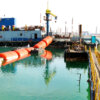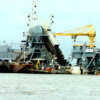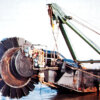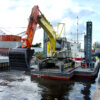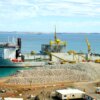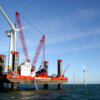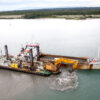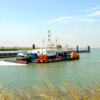Jack-up pontoons are self-elevating platforms used to carry dredging equipment, such as cranes, boosters or soil investigation equipment to work sites.
Purpose built
In recent years, a wide range of sizes of these jack-up platforms have been built to fulfil a variety of different roles from working close to shore to working in waters of 50 metres depth.
From smaller jack-ups, which are modular self-elevating platforms, to powerful vessels with 1200 to 2750 tonne pre-load per leg capacity and a crane capacity of 600 tonnes, jack-ups are there for a variety of operations such as:
- near-shore marine operations including geotechnical site investigation,
- piling,
- directional drilling,
- blasting,
- pipelaying and
- trench excavation,
- placement of windmill foundations at sea.
Construction of a jack-up
Jack-up pontoons have three or more legs that used to either aid positioning or transmit the forces generated by the item of equipment to the ground. Elevating jack-up pontoons are constructed as a sturdy monohull with strong legs and hoisting systems. Their heavy structure allows the full weight of the pontoon and the equipment mounted on it to be carried on the legs. Using a centrally controlled hoisting system, the pontoon can also be raised to clear the water level.
Jack-up pontoons that use their legs for positioning are often designed as modular units which allows them to be transported in standard shipping containers.






